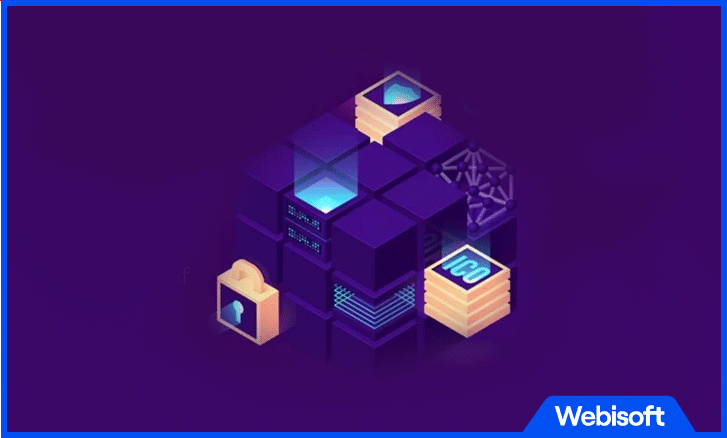Welcome to the world of Blockchain 4.0! In this era of technological advancement, blockchain technology has undergone a remarkable evolution, giving rise to Blockchain 4.0 – the next generation of blockchain innovation. Blockchain 4.0 represents a significant leap forward, introducing groundbreaking features and capabilities that go beyond the limitations of previous generations.
From enhanced scalability and interoperability to the integration of emerging technologies, Blockchain 4.0 holds immense potential to transform industries and revolutionize the way we interact with digital systems.
In this article, we will delve into the concept of Blockchain 4.0, exploring its evolution, key characteristics, enabling technologies, exciting applications, and the challenges and considerations that come along with its implementation.
So fasten your seatbelts as we embark on this journey into the world of Blockchain 4.0 and discover the exciting possibilities that lie ahead!
Contents
- 1 Evolution of Blockchain Technology
- 2 What is Blockchain 4.0?
- 3 Definition and Key Characteristics
- 4 Advancements and Key Features of Blockchain 4.0
- 5 Key Technologies Enabling Blockchain 4.0
- 6 Applications and Use Cases of Blockchain 4.0
- 7 Challenges and Considerations
- 8 Webisoft: Your Trusted Companion for Blockchain 4.0 and Beyond!
- 9 Conclusion
Evolution of Blockchain Technology
Blockchain technology has undergone several significant transformations, with each generation introducing new capabilities and addressing the limitations of its predecessor. Let’s delve into the evolution of blockchain technology:
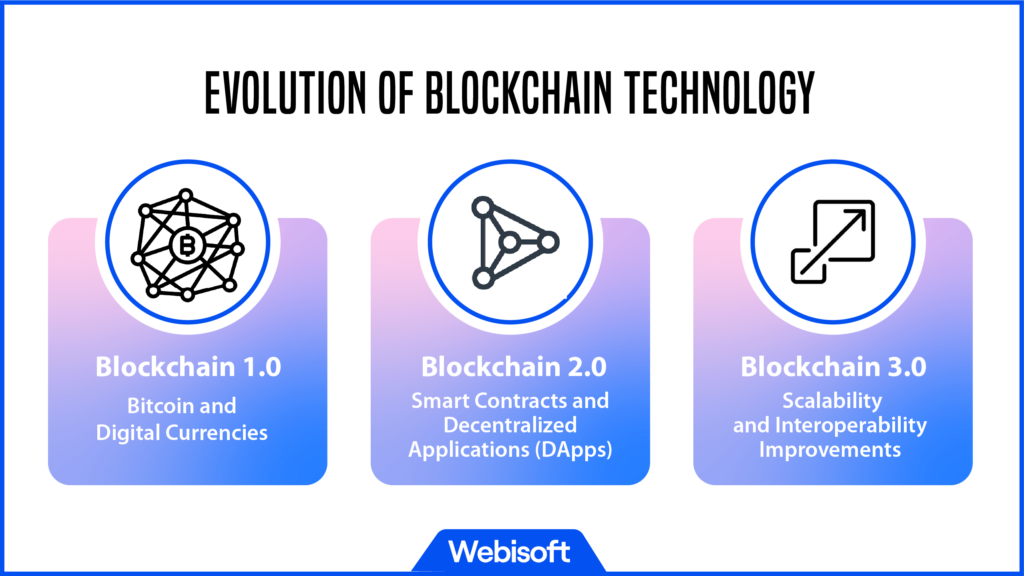
Blockchain 1.0: Bitcoin and Digital Currencies
Blockchain 1.0 refers to the initial phase of blockchain technology, primarily associated with the creation of Bitcoin and other digital currencies. The advent of Bitcoin in 2009 marked the introduction of decentralized, peer-to-peer electronic cash systems. This era introduced key blockchain trends such as secure and transparent transactions without intermediaries.
The primary application was the transfer of digital assets in a trustless manner, where transactions were recorded on a public ledger known as the blockchain. However, Blockchain 1.0 was limited in its functionality beyond currency transactions.
Blockchain 2.0: Smart Contracts and Decentralized Applications (DApps)
Blockchain 2.0 expanded the capabilities of blockchain technology by introducing smart contracts and decentralized applications (DApps). Ethereum, launched in 2015, played a pivotal role in popularizing this concept. Smart contracts are self-executing contracts with predefined rules and conditions encoded within the blockchain.
They enable the automation and execution of agreements without the need for intermediaries. This breakthrough facilitated the development of decentralized applications, where developers could build a wide range of applications on top of blockchain platforms.
DApps utilize smart contracts to create decentralized and transparent systems for various purposes, such as decentralized finance (DeFi), supply chain management, and identity verification.
Blockchain 3.0: Scalability and Interoperability Improvements
Blockchain 3.0 aimed to improve scalability and interoperability. Layer 2 protocols like Lightning Network and Raiden Network increased transaction throughput. Interoperability solutions like Polkadot and Cosmos enabled different blockchains to communicate and share data securely. Alternative consensus mechanisms like DPoS enhanced scalability.
These advancements set the stage for the emergence of more sophisticated blockchain applications in Blockchain 4.0.
What is Blockchain 4.0?
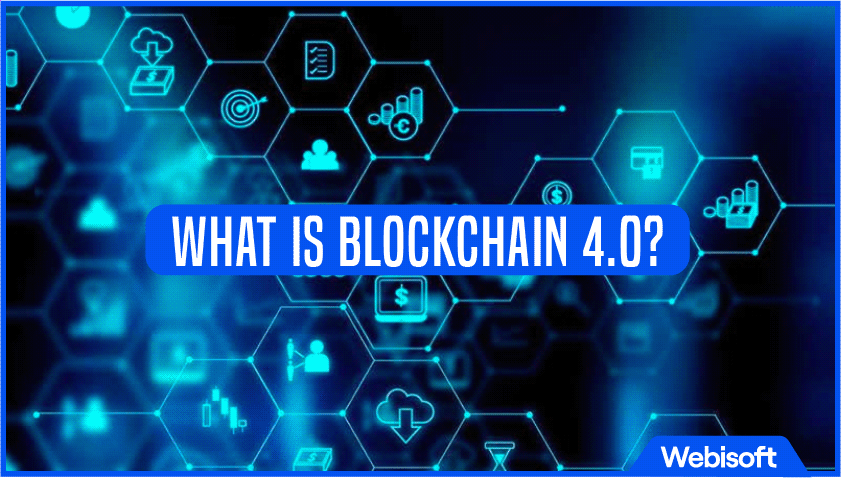
Blockchain 4.0 represents the next phase of blockchain technology, characterized by further advancements and enhanced features that go beyond the capabilities of previous generations. Let’s explore the definition, key characteristics, and notable advancements of Blockchain 4.0.
Definition and Key Characteristics
Blockchain 4.0 can be defined as an advanced iteration of blockchain technology that leverages cutting-edge innovations to address existing challenges and unlock new possibilities. It builds upon the foundations of previous generations and incorporates key characteristics such as:
Scalability
Blockchain 4.0 aims to overcome the scalability limitations of earlier versions by implementing novel techniques, such as sharding, state channels, or layer two solutions. These approaches allow for higher transaction throughput and improved performance.
Interoperability
Blockchain 4.0 emphasizes seamless interoperability between different blockchain networks and protocols. It enables the secure exchange of assets and data across multiple platforms, facilitating collaboration and expanding the scope of decentralized applications.
Security and Privacy
Blockchain 4.0 places a strong emphasis on robust security measures and enhanced privacy features. It explores advanced cryptographic techniques, zero-knowledge proofs, and privacy-preserving protocols to ensure the confidentiality of sensitive data while maintaining the transparency and integrity of the blockchain.
Governance and Consensus Mechanisms
Blockchain 4.0 explores innovative governance models and consensus mechanisms to address the challenges of decentralized decision-making. It aims to foster community participation, improve consensus efficiency, and enhance network governance through decentralized voting, stakeholder engagement, or liquid democracy.
Advancements and Key Features of Blockchain 4.0
Blockchain 4.0 introduces several notable advancements and key features that distinguish it from earlier generations:
Integration with Emerging Technologies
Blockchain 4.0 leverages the integration of emerging technologies like the Internet of Things (IoT), Artificial Intelligence (AI), and Big Data. This integration enables the development of smart cities, autonomous systems, and machine-to-machine transactions, expanding the potential applications and impact of blockchain technology.
Enhanced Smart Contracts
Blockchain 4.0 enhances the functionality of smart contracts, making them more flexible, secure, and capable of complex logic. It incorporates advancements in formal verification, allowing for automated verification and validation of contract code to ensure accuracy and reliability.
Tokenization and Digital Assets
Blockchain 4.0 places a greater focus on tokenization and the representation of real-world assets on the blockchain. It enables the creation and management of digital assets, such as digital identities, intellectual property rights, or fractional ownership of physical assets, fostering new economic models and asset management paradigms.
Sustainability and Energy Efficiency
Blockchain 4.0 explores energy-efficient consensus mechanisms and environmentally friendly approaches to mitigate the energy consumption associated with traditional proof-of-work (PoW) consensus algorithms. It also facilitates the tracking and verification of sustainable practices, promoting transparency and accountability in areas like supply chain sustainability or carbon credits.
Enhanced User Experience
Blockchain 4.0 emphasizes improving the user experience and accessibility of blockchain applications. It strives for intuitive interfaces, seamless integration with existing systems, and improved scalability to support mass adoption.
Blockchain 4.0 represents a significant step forward in the evolution of blockchain technology, opening up new possibilities for secure, scalable, and interoperable decentralized applications across various industries and domains.
Key Technologies Enabling Blockchain 4.0
Blockchain 4.0 harnesses the power of various advanced technologies to enhance its capabilities and address key challenges. Let’s explore the key technologies enabling Blockchain 4.0:
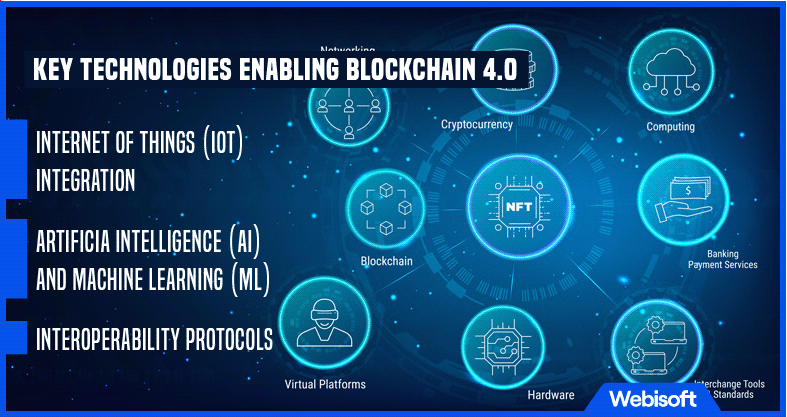
Internet of Things (IoT) Integration
The integration of blockchain with the Internet of Things (IoT) is a vital aspect of Blockchain 4.0. IoT devices generate vast amounts of data that can be securely and transparently recorded on the blockchain. By combining IoT with blockchain, a decentralized and trusted infrastructure for managing IoT data and transactions is created.
Blockchain ensures data integrity and immutability and enables secure peer-to-peer communication among IoT Blockchain ecosystems. This integration enables new use cases such as supply chain traceability, smart cities, autonomous vehicles, and remote device management.
Artificial Intelligence (AI) and Machine Learning (ML)
The fusion of blockchain technology with Artificial Intelligence (AI) and Machine Learning (ML) capabilities brings about significant advancements in Blockchain 4.0. AI and ML algorithms can analyze and extract valuable insights from the vast amount of data stored on the blockchain. They can help automate decision-making processes, detect patterns, and enhance predictive capabilities.
Additionally, AI-powered smart contracts can dynamically adapt based on real-time data, making them more intelligent and efficient. The combination of blockchain and AI/ML facilitates advanced data analytics, fraud detection, personalized services, and brilliant automated contract execution.
Interoperability Protocols
Interoperability is a crucial requirement for Blockchain 4.0, as it aims to connect different blockchain networks and enable seamless communication and data exchange. Interoperability protocols, such as Polkadot and Cosmos, and interoperability-focused blockchains, like ICON, facilitate cross-chain compatibility and interoperability.
These protocols provide the infrastructure for assets and information to flow across different blockchains securely. They enable the transfer of tokens, smart contracts, and data between heterogeneous blockchain networks, fostering collaboration and expanding the possibilities for decentralized applications.
Scalability Solutions
Scalability has been a persistent challenge for blockchain technology, and Blockchain 4.0 seeks to overcome these limitations. Various scalability solutions have emerged to address this issue. Layer 2 protocols, like the Lightning Network for Bitcoin and the Raiden Network for Ethereum, enable off-chain transactions that reduce congestion on the main blockchain, increasing transaction throughput.
Sharding, another scalability technique, partitions the blockchain network into smaller shards, allowing parallel processing of transactions. Additionally, the implementation of alternative consensus mechanisms, such as delegated proof-of-stake (DPoS), improves scalability by increasing transaction processing speed and network capacity.
The integration of IoT, AI/ML, interoperability protocols, and scalability solutions in Blockchain 4.0 expands its potential applications, improves efficiency, and provides a foundation for more sophisticated and scalable decentralized systems. These key technologies collectively contribute to the advancement and maturation of Blockchain 4.0, propelling it toward widespread adoption across various industries and sectors.
Applications and Use Cases of Blockchain 4.0
Blockchain 4.0 introduces a wide range of applications and use cases across various industries. Let’s explore some of the key areas where Blockchain 4.0 is making a significant impact:
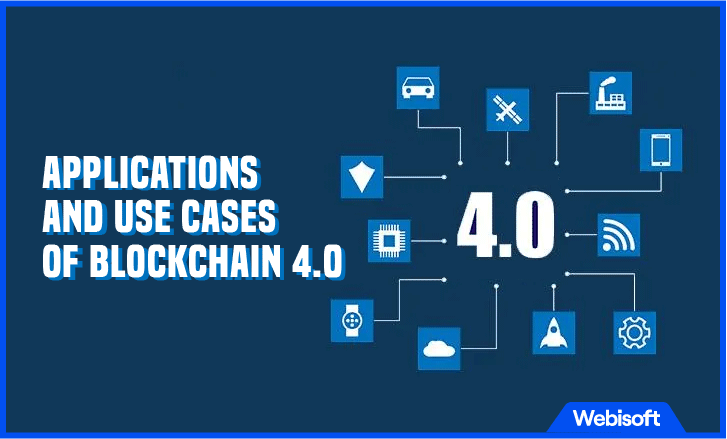
Supply Chain Management and Traceability
Blockchain 4.0 revolutionizes supply chain management by providing end-to-end traceability and transparency. With blockchain in manufacturing, every step of the supply chain can be securely recorded, including the origin, manufacturing, transportation, and delivery of products. This enables enhanced visibility, reduces counterfeiting, improves quality control, and ensures ethical sourcing.
Consumers can verify the authenticity and provenance of products, fostering trust and accountability in supply chains. Blockchain-based supply chain solutions are being implemented in industries such as food and agriculture, luxury goods, pharmaceuticals, and logistics.
Healthcare and Medical Records Management
In the healthcare industry, Blockchain 4.0 offers secure and interoperable solutions for managing medical records, ensuring data integrity, and streamlining processes. Patient records stored on the blockchain can be securely accessed by authorized healthcare providers, improving patient care and enabling better coordination among different medical entities.
Blockchain technology enhances data privacy, facilitates consent management, and simplifies medical billing and insurance claims processing. It also enables secure sharing of research data, leading to advancements in medical research and personalized medicine.
Decentralized Finance (DeFi) and Banking
Blockchain 4.0 is driving the evolution of decentralized finance (DeFi) and transforming traditional banking systems. DeFi applications built on blockchain enable peer-to-peer lending, decentralized exchanges, automated market-making, and yield farming, among other financial services. Blockchain-based smart contracts facilitate automated and transparent financial transactions without intermediaries.
This fosters financial inclusivity, eliminates the need for traditional banks, reduces costs, and enables individuals to have full control over their assets. DeFi also offers opportunities for individuals in underserved regions to access financial services and participate in global markets.
Energy and Sustainability
Blockchain 4.0 plays a vital role in promoting energy efficiency and sustainability. It facilitates the creation of transparent and decentralized energy markets, enabling peer-to-peer energy trading and incentivizing renewable energy production. Blockchain-based platforms can track the origin and impact of energy sources, ensuring transparency and verifying the use of clean energy.
Smart contracts on the blockchain automate energy transactions, optimize energy distribution, and enable grid management. Blockchain technology also enables the monitoring and verification of carbon credits, supporting efforts to mitigate climate change and achieve sustainability goals.
Governance and Voting Systems
Blockchain 4.0 offers innovative solutions for transparent and secure governance and voting systems. Blockchain-based platforms enable decentralized decision-making processes, where voting outcomes are recorded immutably on the blockchain.
This ensures transparency, enhances security, and reduces the risk of tampering or fraud. Blockchain-based governance systems facilitate community-driven decision-making, enabling stakeholders to participate in the decision-making process directly.
This can be applied in various contexts, such as decentralized autonomous organizations (DAOs), public elections, shareholder voting, and community governance in blockchain networks.
These are just a few examples of the diverse applications and use cases of Blockchain 4.0. The technology’s capabilities, including its transparency, immutability, security, and interoperability, make it suitable for transforming multiple industries and driving innovation in the digital era.
The potential of Blockchain 4.0 extends beyond the areas mentioned, and its impact is expected to continue expanding as adoption grows.
Challenges and Considerations
While Blockchain 4.0 holds great promise, there are several challenges and considerations that need to be addressed for its widespread adoption. Let’s explore some of the key challenges associated with Blockchain 4.0:
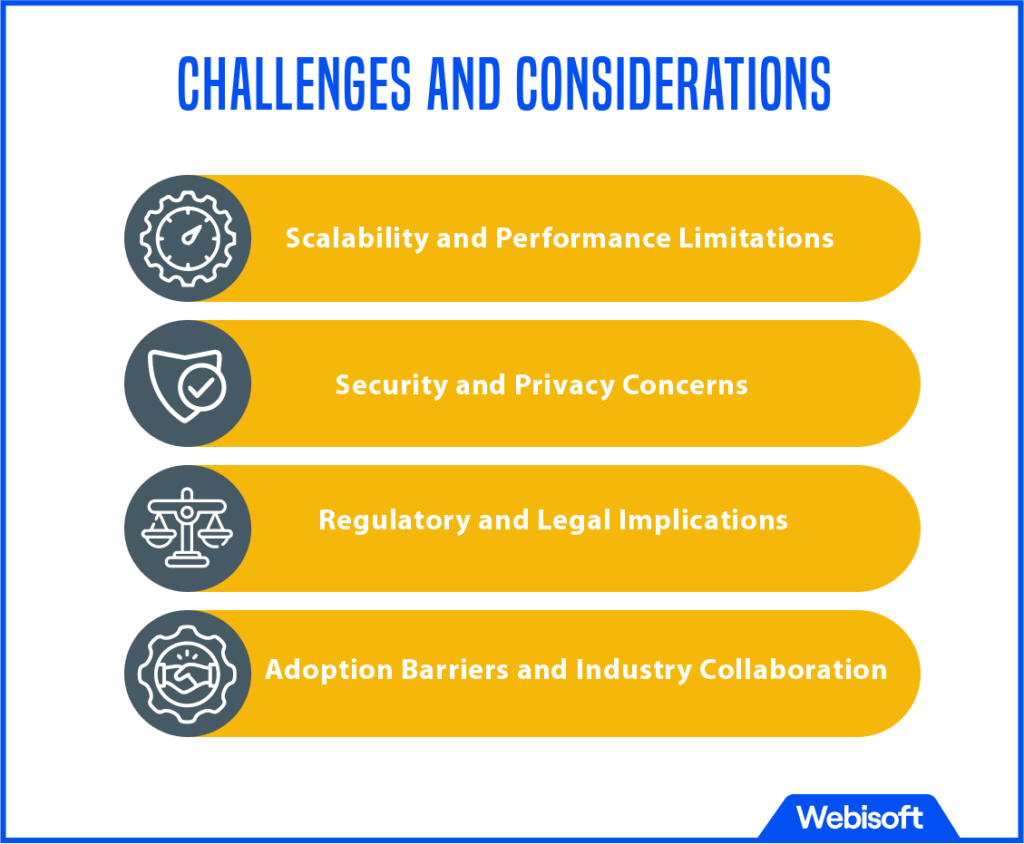
Scalability and Performance Limitations
Scalability remains a persistent challenge for blockchain technology. As the number of transactions increases, the scalability of blockchain networks becomes crucial. Blockchain 4.0 aims to overcome this challenge through techniques like sharding, layer two solutions, and alternative consensus mechanisms.
However, implementing these solutions at scale and ensuring seamless interoperability between different blockchain networks is complex and requires further research and development.
Security and Privacy Concerns
Blockchain 4.0 introduces advanced security features, but it also presents new security and privacy considerations. While the blockchain itself is inherently secure, vulnerabilities can arise from smart contracts, wallet integrations, or interactions with external systems. Privacy concerns may arise when sensitive data is stored on a public blockchain or when private data is accessed by multiple parties.
Striking the right balance between transparency and privacy is crucial, and the development of robust security measures and privacy-enhancing technologies is imperative to ensure the protection of data and assets.
Regulatory and Legal Implications
The regulatory landscape surrounding blockchain technology is still evolving. Different jurisdictions have varying regulations and legal frameworks, which can present challenges for widespread adoption. Compliance with existing regulations, such as data protection and anti-money laundering laws, can be complex when using blockchain technology.
Governments and regulatory bodies need to develop clear guidelines and frameworks to address legal and regulatory challenges associated with Blockchain 4.0, promoting innovation while safeguarding consumer protection, privacy, and security.
Adoption Barriers and Industry Collaboration
Achieving widespread adoption of Blockchain 4.0 requires overcoming adoption barriers and fostering industry collaboration. Resistance to change, lack of awareness, and uncertainty about the benefits and risks of blockchain technology can impede adoption.
Additionally, the interoperability of different blockchain networks and the integration of legacy systems pose technical challenges. Collaborative efforts among industry stakeholders, including businesses, technology providers, regulators, and standards organizations, are essential to overcome these barriers and establish common standards and best practices.
Moreover, education and skill development are crucial to ensure a skilled workforce capable of implementing and leveraging Blockchain 4.0 solutions effectively. Collaboration among academia, industry, and research institutions can help drive innovation, knowledge sharing, and the development of talent in the blockchain space.
Webisoft: Your Trusted Companion for Blockchain 4.0 and Beyond!
Webisoft, a leading technology company, is revolutionizing the blockchain landscape with its innovative solutions and deep expertise. With a strong focus on Blockchain 4.0, Webisoft is at the forefront of driving the adoption of decentralized technologies.
Our comprehensive services, showcased on our website, empower businesses to leverage the full potential of Blockchain 4.0. From custom blockchain development to smart contract implementation and decentralized application (DApp) creation, Webisoft offers a range of solutions that enable organizations to embrace the power of blockchain technology.
By leveraging our expertise, businesses can enhance transparency, security, and efficiency while embracing the decentralized future envisioned by Blockchain 4.0. Partner with Webisoft today and unlock the true potential of blockchain for your organization.
Conclusion
To sum up, Blockchain 4.0 marks a substantial stride in blockchain technology, offering improved scalability, interoperability, and compatibility with emerging tech. This promises to reshape industries and revolutionize digital infrastructures. Yet, hurdles like scalability, security, regulations, and cross-industry collaboration need tackling for broad acceptance.
By surmounting these obstacles, we can harness the transformative might of Blockchain 4.0, fostering a decentralized, transparent, and inclusive digital ecosystem. The trajectory of Blockchain 4.0 is brimming with potential, paving the way for a more efficient and trustworthy digital future.
Ready to be part of this digital revolution? Webisoft is equipped to guide you through the nuances of Blockchain 4.0. Connect with us today to create your path in this exciting new world of possibilities.
